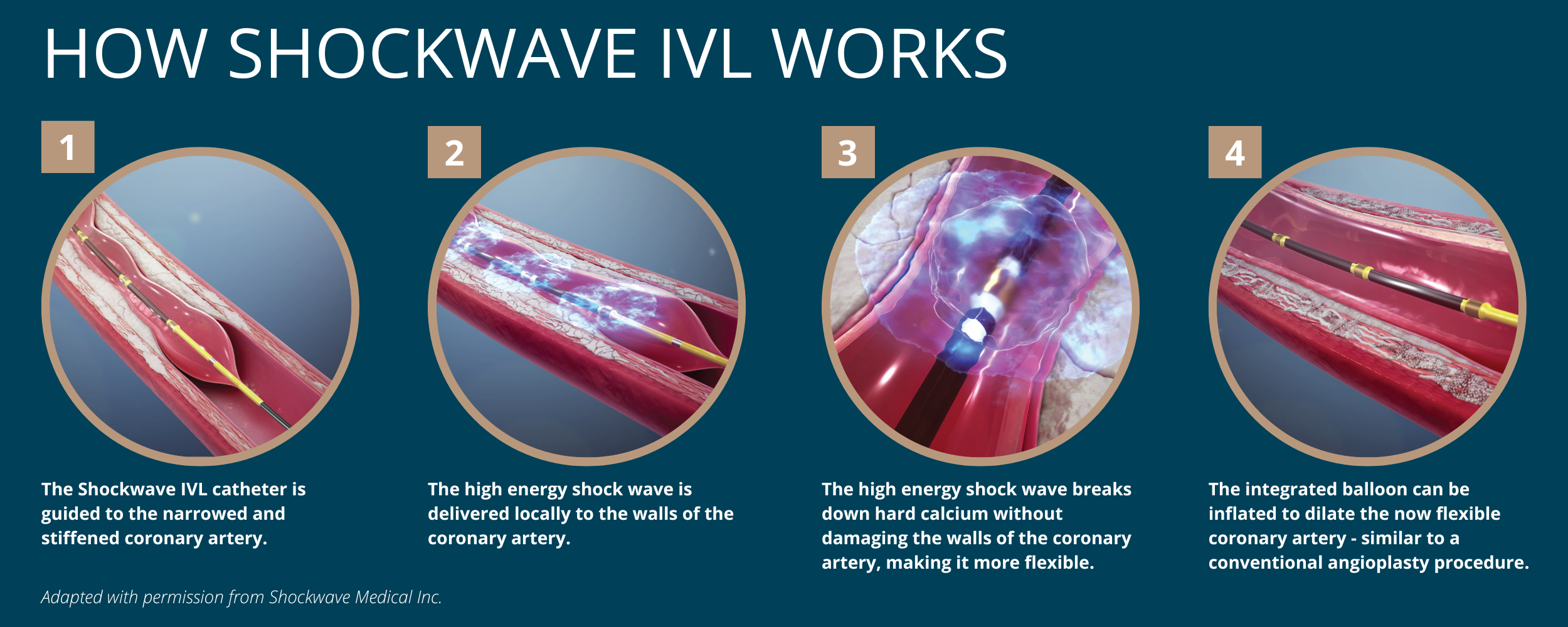Our cardiology team are leading in the research and use of a ground-breaking new technology, called Shockwave IVL, to widen narrowed coronary arteries that are too difficult to be treated with current methods.
Tackling clogged coronary arteries
Coronary arteries supply oxygenated blood to the heart to keep it beating. However, in older people they can become narrowed and stiff, resulting in coronary heart disease.
A build-up of fatty substances – including cholesterol – results in them becoming narrow, and a build-up of hard calcium in the walls of the coronary arteries can make them stiffen. Diabetes, chronic kidney disease and being overweight can all increase the risk of this hard calcium building up.
As blood flow to the heart becomes restricted by these narrowed coronary arteries, patients may experience pain in their chest – called angina, as well as a shortness of breath. If the coronary arteries become completely blocked, they may experience a heart attack.
Thankfully, there are a range of treatments available for coronary heart disease. Lifestyle changes, such as quitting smoking, eating more healthily and regular exercise can all help reduce the risk of a heart attack. Medications to lower cholesterol and thin the blood may also help. However, sometimes more invasive methods may be needed to widen the coronary arteries, in the form of angioplasty.
Angioplasty is where a thin tube, called a catheter, is inserted through a small incision in the artery of a patient’s groin, wrist or arm. It is then safely guided by medical imaging to the heart, where a cardiologist works to widen the narrowed coronary artery with a small inflatable balloon at the end of the catheter. Sometimes, a stent – a small tube made of plastic or wire mesh – is left in place of the widened artery to keep it open.
Unfortunately, in 10-15% of patients, so much hard calcium has built up in the walls of their coronary arteries that they are too stiff for a conventional angioplasty procedure to widen them. Thankfully, the cardiology team at our centre are trialling an innovative new technology to help tackle this problem, called Shockwave IVL.
An innovative solution using an old technology
Lithotripsy is a medical procedure that has been safely used for over 30 years to treat kidney stones. It works by using sound waves – also called high-energy shock waves – to break down large stones into smaller pieces, that can then leave the body through a patient’s urine. It uses a large machine, called a lithotripter, placed over a patient’s abdomen to deliver the shock waves.
The new Shockwave IVL takes this lithotripsy technology and packages it into something much smaller – a very thin 0.014-inch guidewire with a shock wave emitter at its end. This enables cardiologists to use a technique similar to a conventional angioplasty procedure to reach a narrowed coronary artery and deliver the shock waves locally to break down hard calcium. Once the calcium is broken down in the walls of the coronary arteries, they become much more flexible. A small integrated balloon at the end of the Shockwave IVL catheter is then used to widen the artery, along with the placement of a stent if needed too.

How shockwave IVL works
Advancing research to expand access
Dr Jonathan Hill, consultant cardiologist at Royal Brompton & Harefield Hospitals Specialist Care, facilitated and coordinated the recent DISRUPT CAD III trial of the technology as the co-principle investigator and has trained cardiologists on the innovative procedure across the world. The trial, which enrolled 384 patients at 47 sites in the United States, France, Germany and the UK, aimed to generate the data needed to obtain approval from the US Food and Drugs Administration to use Shockwave IVL to treat patients in the US.
Royal Brompton’s cardiology team has been pivotal in leading research into this new technology’s effectiveness both in the UK and Europe in recent years, which has led to the technology being trialled for use in the US. Professor Carlo Di Mario, honorary consultant cardiologist, was the co-principle investigator of earlier Disrupt CAD I and II studies that trialled the new Shockwave IVL technology on patients across the UK and Europe. Dr Hill was also an investigator on these studies.
Dr Hill said:
“I am delighted to have been part of this important global trial. The results of this study show that the procedure is safe and effective for patients with moderate to severe calcification. It will make a huge difference to clinicians’ treatment of CAD [coronary artery disease]. It also has quick recovery times for the patient, which is key.”

